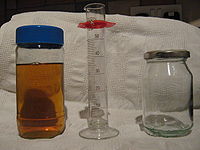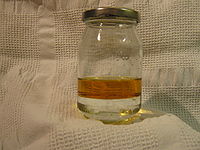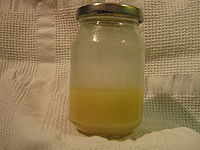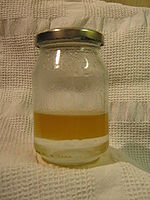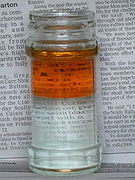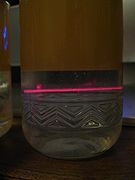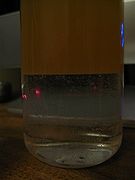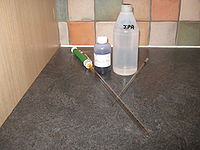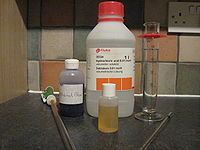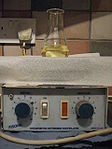Soap tests
Soap can be seen as one of the four main contributors to fuel system failures and faults. The others being methanol still in the fuel, poorly converted fuel and wet fuel. There are two ways of testing:
- the 50/50 shake test
- a titrated test that will give a ppm (parts per million) result
Contents
50/50 shake test
The 50/50 test is relatively simple to perform.
Take a sample of dried, finished fuel, for example, 50ml. Place it into a clean glass container and add 50ml of deionised water. Deionised water is best, because the hardness of tapwater has an effect on the results. Then shake the living daylights out of it. This will create an emulsion between the water and the oil.
Allow it to stand. Within a few minutes you should see the fuel and water begin to split. When the fuel/water sample has fully separated you can then determine the results by a simple visual check. For a good pass, indicating little or no soap present, the emulsion should separate quickly (usually within five minutes) and the water layer should have the same crystal clear clarity it had before the test began. The fuel layer on top will now be cloudy. This is perfectly normal as the bio has taken on some of the moisture from the water.
If the water is creamy, or looks like diluted milk, then there is soap present. A layer between the water and the biodiesel aka "the dreaded white stuff" can indicate the presence of soap, mono or di-glycerides in the fuel - though this is very subjective.
If you don't have deionised water, use warm tapwater - the extra heat helps the emulsions formed by shaking to seperate nicely.
- 50/50 water shake up test
Assessing water clarity
There a few ways to assess the water clarity after a 50/50 test
- Hold it up to the light to look for milkyness
- See if you can read newsprint through it
- Shine a laser through it
Commercial particulate counters measure laser backscatter to assess particle levels. We can use a simple laser pointer to show up any soap particles in a similar way.
- Water clarity tests
Laser pointer test - much better - a sample from the same batch but after passing through a dry wash tower
Titrated soap test
This test is a more definitive way of assessing your fuel. While the 50/50 shake test gives you an indication of whether soap is present, this test will give you the results in a more scientific way. By performing the test and using a simple formula, we can then determine the parts per million (ppm) of soap within the fuel. Depending on the results, you can look at ways of improving your process or it can give you the satisfaction of telling you that you’re producing fuel of the highest quality.
Required equipment
Some laboratory instruments and lab grade chemicals are needed in order to achieve a distinctive colour change when the sample being tested reaches a known acidity:
- magnetic stirrer.
- 100ml conical flask
- 50ml measuring cylinder
- 10ml pipette
- 0.2ml pipette
- High purity isopropyl alcohol (aka IPA or isopropanol)
- 0.4% bromophenol blue indicator
- 0.01N hydrochloric acid (HCl)
- 0.1% NaOH solution
- A sample of finished biodiesel
- Soap titration equipment
Performing the test
Using the cylinder measure out 50ml of IPA and pour it into the conical flask. The first thing we must do is blank the alcohol. Given that the IPA is likely to be acidic rather than alkaline, and that you will be using HCl to titrate, the easiest way would be to add some NaOH solution, used in titrating WVO, to the IPA. Then add a few drops of bromophenol blue indicator and then add your HCl solution until the solution just turns yellow.
With the 10ml pipette draw up 12ml of biodiesel and add it to the blanked IPA in the conical flask. Adding the biodiesel, which if it contains soap should be alkaline, should revert the colour again so that you can titrate it with the HCl solution. Turn on the magnetic stirrer and add more bromophenol blue indicator if required. The solution should now be a green/blue colour. Using the 0.2ml pipette, slowly, (drop wise) add the HCl solution until you reach the yellow end point. (You should be aware that the colour change can be very rapid if the soap content is low and care should be taken when adding the acid so that you do not exceed the point at which the yellow colour is achieved). Note how much HCl has been used and calculate for soap in ppm using the formula below.
For NaOH derived biodiesel:
HCl used × 304 = ppm of soap
For KOH derived biodiesel: HCl used × 320 = ppm of soap
Understanding the results
Acceptable ASTM (American Society for Testing and Materials) limits for soap - NaOH Reacted biodiesel - No more than 41 PPM (0.041%) - KOH Reacted biodiesel - No more than 66 PPM (0.066%)
Reading The Test: - If your fuel tests within the ASTM limits, well done. Your methods are first rate.
- 100-200 PPM, it shouldn't pose any real problems associated with fuel filter clogging.
- 200-300 PPM, you should be looking at ways of improving your process.
- 300-400 PPM, the likelihood of filter clogging may increase and soap content is getting high.
- 400+ PPM, do not use this fuel in a modern CRD (Common Rail Diesel) engine. Your soap and methanol removal methods should be looked at again.
- 500+ PPM, there's a good chance you'll see cloudy water in a 50/50 shake test.
This information comes from Graydon Blair and his explanation of how these figures were derived is as follows:
The research that I based my figures on was done by Piedmont Biofuels out of Pittsboro, North Carolina. Rachel (the head chemist there) did a bunch of research and was able to extrapolate the approximations for soap ppm in accordance with the ASTM standard for allowable sodium & potassium in biodiesel (EN 14538).
Somewhere buried on infopop is an excellent post where she went through how she figured it out. A couple other chemists also double-checked the work and came up with the same thing.
I believe the difference is due to the different atomic weights of sodium (23)& potassium (39)and assume the soap is the oleate.
The ASTM standard for sodium & potassium is no more than 5 PPM. However, when they're bound up in soap, they're just a single component of the soap salts. So, I believe Rachel did the math to figure out potassium based salts & sodium based salts & figured out what 5 PPM of each would be and came up with the figures.
